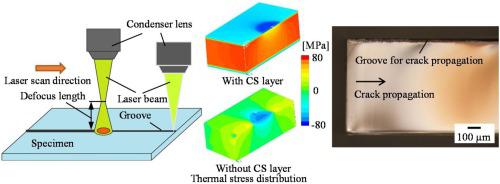当前位置:
X-MOL 学术
›
J. Mater. Process. Tech.
›
论文详情
Our official English website, www.x-mol.net, welcomes your feedback! (Note: you will need to create a separate account there.)
CO2 laser cleavage of chemically strengthened glass
Journal of Materials Processing Technology ( IF 6.3 ) Pub Date : 2021-03-01 , DOI: 10.1016/j.jmatprotec.2020.116961 Tatsuaki Furumoto , Yohei Hashimoto , Hisashi Ogi , Tomoya Kawabe , Mitsugu Yamaguchi , Tomohiro Koyano , Akira Hosokawa
Journal of Materials Processing Technology ( IF 6.3 ) Pub Date : 2021-03-01 , DOI: 10.1016/j.jmatprotec.2020.116961 Tatsuaki Furumoto , Yohei Hashimoto , Hisashi Ogi , Tomoya Kawabe , Mitsugu Yamaguchi , Tomohiro Koyano , Akira Hosokawa

|
Abstract It is necessary to strengthen glass surfaces to protect mobile electric devices from unexpected scratches and breakages, and various strengthening methods are available to this end. However, strengthened glass is difficult to cut and finish owing to the high compressive stress on the glass surface. In this work, chemically strengthened glass was separated using a fracture control technique. The initial crack for the crack propagation was generated through a thermal shock induced by laser beam irradiation, and the thermal stress distribution inside the strengthened glass was simulated via a finite element analysis. In addition, the influence of the laser conditions on the cleavage characteristics was evaluated experimentally, and a groove was fabricated via a short-pulsed laser to improve the quality of the cleaved surface. The thermal stress induced by the laser beam irradiation was affected by the stress distribution inside the strengthened glass, and the depth of the initial crack was required to exceed that of the compressive stress layer to realize the crack propagation through laser beam irradiation. The minimum energy density required for the thermal stress cleavage decreased with the increase in the initial crack depth, and the energy density required for the thermal stress cleavage was large when the compressive stress on the surface was high. The compressive stress layer on the surface helped reduce the lateral crack at the tip of the initial crack, and the tensile stress inside the specimen helped realize high-quality cleavage. In addition, the groove fabricated using the short-pulsed laser acted as the initial point for the crack propagation and helped prevent the thermal damage induced by the laser beam irradiation applied as the heat source.
中文翻译:

化学强化玻璃的 CO2 激光裂解
摘要 为了保护移动电子设备免受意外划伤和破损,必须对玻璃表面进行强化,为此可以使用各种强化方法。然而,由于玻璃表面的高压缩应力,强化玻璃难以切割和精加工。在这项工作中,使用断裂控制技术分离了化学强化玻璃。裂纹扩展的初始裂纹是通过激光束照射引起的热冲击产生的,并通过有限元分析模拟强化玻璃内部的热应力分布。此外,通过实验评估激光条件对解理特性的影响,并通过短脉冲激光制造凹槽以提高解理表面的质量。激光束辐照引起的热应力受强化玻璃内部应力分布的影响,要求初始裂纹的深度超过压应力层的深度,才能通过激光束辐照实现裂纹扩展。热应力解理所需的最小能量密度随着初始裂纹深度的增加而降低,当表面压应力较高时,热应力解理所需的能量密度较大。表面的压应力层有助于减少初始裂纹尖端的横向裂纹,试样内部的拉应力有助于实现高质量的解理。此外,
更新日期:2021-03-01
中文翻译:

化学强化玻璃的 CO2 激光裂解
摘要 为了保护移动电子设备免受意外划伤和破损,必须对玻璃表面进行强化,为此可以使用各种强化方法。然而,由于玻璃表面的高压缩应力,强化玻璃难以切割和精加工。在这项工作中,使用断裂控制技术分离了化学强化玻璃。裂纹扩展的初始裂纹是通过激光束照射引起的热冲击产生的,并通过有限元分析模拟强化玻璃内部的热应力分布。此外,通过实验评估激光条件对解理特性的影响,并通过短脉冲激光制造凹槽以提高解理表面的质量。激光束辐照引起的热应力受强化玻璃内部应力分布的影响,要求初始裂纹的深度超过压应力层的深度,才能通过激光束辐照实现裂纹扩展。热应力解理所需的最小能量密度随着初始裂纹深度的增加而降低,当表面压应力较高时,热应力解理所需的能量密度较大。表面的压应力层有助于减少初始裂纹尖端的横向裂纹,试样内部的拉应力有助于实现高质量的解理。此外,


























 京公网安备 11010802027423号
京公网安备 11010802027423号